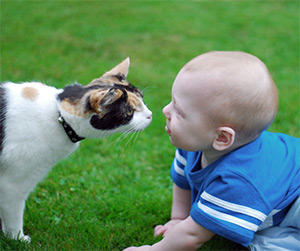Helping Your Cat Adjust to a New Baby with Comfort Zone Synthetic Pheromones
Expecting and welcoming a new baby into the home is exciting for families, but this significant life change can be confusing and stressful for your cat. Cats thrive on the predictability of a daily routine and familiarity, and the arrival of a baby will bring new smells, sounds, and changes in daily life that can disrupt their sense of security. As a clinical cat behaviourist, I have some valuable tips on how you can make this transition as stress-free as possible for your cat, and I always recommend using Comfort Zone synthetic pheromone products to help ease this transitional phase and support a harmonious home for both your cat and your growing family.

Why a New Baby Can Be Stressful for Cats
A cat’s home environment is their sanctuary, and any changes to their routine can lead to anxiety and stress-related behaviors. Common challenges you may encounter with the new arrival may include:
New smells and sounds: Babies bring unfamiliar scents, from soiled nappies and milk to creams and lotions, and new sounds, such as crying, which can be unsettling for a cat.
Changes in routine: Your cat may be used to receiving your sole attention at specific times, and a newborn baby’s unpredictable schedule can disrupt that.
Restricted access to spaces: Cats that previously had free access to the home may suddenly find themselves locked out of certain rooms, such as the nursery or lounge area if the new mum wants to feed the baby without a curious cat.
More visitors and activity: Increased visits from family, medical professionals, and friends who want to meet the baby can create additional stress.rs.
How Comfort Zone Synthetic Pheromones Can Help
Synthetic pheromones mimic the natural facial pheromones cats use to mark their territory as safe. Comfort Zone products help reinforce these feelings of security and reduce stress-related behaviors such as hiding, urinating outside the litterbox, overgrooming, or territorial spraying.
1. Comfort Zone Diffuser: Creating a Calm Environment
Plugging in a Comfort Zone Diffuser a few weeks before the baby’s arrival to establish a relaxing atmosphere in key areas where your cat spends time.
If your cat is no longer allowed in certain rooms (such as the nursery), place a diffuser where they can still provide stability. Place this at nose height in a room where they are most frequently located.
3. Comfort Zone Calming Collar: Providing Continuous Support
If your cat is prone to stress or has a history of anxiety, the Comfort Zone Calming Collar can offer continuous pheromone support throughout the transition period. If your cat does not wear a collar, consider placing it in their bed, onto their cat pole, or even in their toy box. The scent will then be absorbed by the toys when you engage in play with them.
This can be particularly helpful for cats who tend to hide or exhibit stress-related behaviors when faced with environmental changes.
Steps to Help Your Cat Adjust to a New Baby
Before the Baby Arrives
1. Gradually introduce new smells and sounds.
Play recordings of baby sounds at a low volume to help desensitise your cat, giving them a positive reward such as praise or a treat while the crying baby sounds are played. You can increase the volume over some time, still rewarding with a treat at the same time, so that when the real baby noises descend in your home, your cat will associate the noise with a positive experience and should not be phased by the noises that are associated with a new baby.
Let your cat explore baby items before the baby arrives. Using a cat calming diffuser in the same room can help create positive associations. Praise your cat and give a treat when your cat has sniffed the new items.
2. Set up new household routines early.
If you anticipate changes in feeding or play schedules, gradually adjust them in advance to avoid a sudden shift after the baby arrives. You may also want another family member to help with their care routine before the arrival so that your cat does not feel abandoned by you and is used to the new caregiver taking charge of their daily routine.
3. Create a safe space for your cat.
Setting up a quiet, baby-free kitty creche zone with their bed, litter box, scratching post, and a Comfort Zone Diffuser to provide a stress-free retreat. Adding resources such as toys on a daily rotational basis. Playing calming music or soporific human voices on the radio can also help.
When the Baby Arrives at Home
1. Make a calm introduction.
Let your cat observe the baby from a comfortable distance without forcing interaction. Give your cat plenty of positive reinforcement (treats, affection) when they remain calm around the baby. Do not pick your cat up and bring it to the baby, no matter how eager you are for them to be friends! Be cat-led in the cat’s time of when and where to come and sniff out the new arrival.
2. Maintain quality one-on-one time with your cat.
Even short, daily play sessions of ten minutes or less can help reassure your cat that it is still a valued member of the household. When the baby naps, take the time to speak to your cat or groom it or have regular hanging out time as you did before the baby arrived.
3. Respect your cat’s boundaries.
Allow your cat to approach and investigate at their own pace. If they choose to retreat, let them. All interaction should be with your cat’s consent.
Scholarly References for Further Reading
1. de Souza Machado, C., Oliveira, P. M., & Olsson, I. A. S. (2020). The effect of environmental changes on stress-related behaviours in domestic cats Journal of Feline Medicine and Surgery, 22(9), 789-798. This study highlights how environmental stressors, such as changes in household dynamics, can impact feline behavior and the role of pheromones in reducing stress.
2. Mills, D. S., Ramos, D., & Estelles, M. G. (2016). Feline stress and human interaction: The role of synthetic pheromones in easing environmental changes. Veterinary Behavior Journal, 14(2), 78-85. Examines the effects of pheromone therapy on reducing feline anxiety in multi-human households.
3. DePorter, T., & Bledsoe, D. (2018). Behavioural adaptation and the use of pheromone therapy in domestic cats facing household transitions Veterinary Clinics of North America: Small Animal Practice, 48(5), 1035-1050. Discusses the use of synthetic pheromones to support cats during major household transitions, such as the arrival of a baby.
A Smooth Transition for Your Cat and Baby
With considered prior preparation and the support of Comfort Zone synthetic pheromones, you can help your cat adjust to life with a new baby while maintaining a harmonious home environment. By gradually introducing changes, providing safe spaces, and reinforcing positive interactions, your cat can feel secure and included in this exciting new chapter of your family’s life. You will feel proactive in your care for your cat and be able to transition them slowly into the new routine of the home.

Amanda Campion
Clinical Feline Behaviourist CAB APBC ABTC

